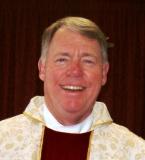Acts 5:27 – 32 / Psalm 150 / Revelation 1:4 – 8 / John 20:19 – 31
This is the homily written for Flohr’s Evangelical Lutheran Church (ELCA) in McKnightstown, Pennsylvania for April 27, 2025 by Fr. Gene Tucker, Interim Pastor. (On this day, no formal sermon was given during the worship service. Rather, the sermon time was used for an occasion of “Stump the Pastor” providing time for members of the congregation to ask questions -- either about the scripture lessons of the day, or regarding aspects of the faith which they may have been wondering about and/or wanting to ask.)
“THE RESURRECTION: MYTH -OR- MYTH?”
(Homily text: John 20: 19 – 31)
A word we use regularly is “myth”. When
this word is used, it often (usually) means something that isn’t at all true.
But there’s another meaning to the word
“myth”, one that we might not think of at all: Its other meaning is something
that is ultimately true, or something that we might say is true with a capital
“T”. Myth in this sense often employs a story or perhaps some weighty
statement.
For example, to exemplify the ultimate
truth of human dignity and equality, this statement is used: “We hold these
truths to be self-evident, that all men (today, we would say all men and women)
are created equal, and that they are endowed by their Creator with certain
inalienable rights….” (The Declaration of Independence). This lofty statement
affirms the ultimate truth of the basic nature of all human persons.
Another example of “myth” in the sense
of being ultimately true (with a capital “T”) might be C. S. Lewis’ story The
Lion, the Witch and the Wardrobe. For Christian readers and viewers of the
movie, it’s impossible not to see the redemption story of our Lord Jesus Christ.
Lewis’ story relates the ultimate truth of Jesus Christ.
Hopefully, these are good illustrations
of this use of the word “myth”.
This morning, we hear the account of the disciple Thomas’ encounter with the risen Christ, an event that took place eight days after Easter Sunday. (So, it’s especially appropriate that we hear and consider this account on this day.)[1]
Let’s recall what John tells us about
Thomas, and his demand to come to believe that the resurrection actually
happened.
We read that, on Easter Sunday, Thomas
was not present when the Lord appeared to the other disciples. In the days
which followed, those who had seen the Lord told Thomas about their encounter.
Thomas replied that he wouldn’t believe their statements unless he, himself,
was able to touch the Lord and to actually put his finger into the Lord’s
wounds. (I think it’s appropriate, at this point, to say that Thomas was simply
taking the approach that many of God’s people in that day and time took…they
wanted to have proof, physical proof, of something before they would believe it
to be true.[2])
Then, on the eighth day[3],
Thomas is present with the others, and Jesus comes into the room, through the
locked door. Jesus knows of Thomas’ demands.[4] He
says to Thomas, “Put your finger here…”
Thomas’ demands, essentially, come down
to this: Does he believe that Jesus’ resurrection is a myth, that is to say,
something that isn’t true at all, and has no basis in fact. Or, is Jesus’
resurrection a myth in the sense of being True with a capital “T”?
Thomas’ demands and his need to have a
basis upon which to believe is ours, as well.
There is a wonderful verse in this
account…When Jesus asks Thomas if he has come to faith because he was able to
physically see the Lord, then the Lord says “blessed are those who have not
seen, and yet have come to believe”.
I don’t know about you, but I believe
there’s an imaginary blank in that statement, one in which you and I can write
our names, for we are those who have come to believe that the Lord did,
actually and truly, rise from the dead on Easter morning, and we have come to
believe and to know this to be true, even though we can see this reality
through the lens of faith.
When we get to the place where we can
write our own names in this imaginary blank in the Lord’s statement, wonderful
things begin to happen. For, you see, accepting the resurrection as “myth” in
the sense that it is the ultimate truth and the ultimate reality of the world’s
history, opens to us an intense, personal and ongoing relationship with the
fulness of God.
Coming to this place marks a new
beginning in our walk with the Lord. There is no other way to begin the journey
on the pathway of faith than to come to the place where we believe that the
resurrection is a “myth”.
Thanks be to God.
AMEN.
[1] This encounter is so important that this Gospel text is appointed to be
read on the Second Sunday of Easter in each of our three-year cycle of
readings.
[2] The same is true of many people today…they demand to have tangible proof
of something before they will believe it to be true. They need to have
physical, scientific proof, of something before they’ll believe it to be real
and true.
[3] I can’t resist saying that this event, which took place on the eighth
day after the resurrection, marks a new beginning for Thomas. In Holy
Scripture, the number eight signifies a new beginning to things.
[4] All throughout John’s Gospel account, Jesus possesses knowledge that
only God would know. This is a marker, in the Fourth Gospel, of Jesus’ one-ness
with God the Father.
